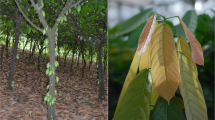Summary
Growth traits, stem form and branch characteristics in three series of well-replicated trials, comprising open-pollinated families of Pinus elliottii Engelmann, were analysed to investigate whether the absolute value of the component of variance for family effect and its relative value (which is equivalent to one-quarter of heritability on individual values) were related, with trial averages of the traits studied taken as productivity indices of the sites tested. The first series, called the foreign selection series, consisted of four trials comprising open-pollinated families from single clones from a Florida seed orchard and from selected trees in Queensland, Australia. Two trials were established in the eastern Transvaal, at Tweefontein and Frankfort State Forests (SF), and two in Zululand, at Dukuduku and KwaMbonambi SF. The second series, called the Zululand selection series, consisted of open-pollinated families from single trees selected in Zululand that were compared in three trials: in the eastern Transvaal at Wilgeboom SF, in Zululand at Dukuduku SF and in the southern Cape at Lottering SF. The third series, called the South African selection series, consisted of open-pollinated families from single trees selected in the different forest areas of South Africa and compared in four trials: two trials in the eastern Transvaal at Tweefontein and Mariti SF and two in the Natal province at Dukuduku and Weza SF. Some positive and linear relationships between absolute sizes of the variance component for family and trial average for all traits studied, except stem form, were discernible for the foreign selections and for the Zululand selections. The South African selections presented a more erratic pattern of variation. However, when the origin of the genetic material was disregarded, the positive trends were undeniable. Curvilinear relationships between relative values and site averages were discernible, when the origin of the genetic material was disregarded. Further research is needed in order to confirm the suggested effect of site on genetic expressivity of open-pollinated families of slash pine grown in South Africa.
Similar content being viewed by others
References
Anderson RL, Bancroft TA (1952) Statistical theory in research. McGraw Hill, New York, 400 pp
Anonymous (1982) Report on commercial timber resources and roundwood processing in South Africa, 1982/83. Forestry Branch, Department of Environment Affairs, Pretoria
Becker WA (1967) Manual of procedures in quantitative genetics, vol 1. Washington State University, Washington, 130 pp
Falconer DS (1983) Introduction to quantitative genetics, 2 nd ed, vol 1. Oliver and Boyd, London, 340 pp
Falkenhagen ER (1985) Genotype by environment interactions in South African pine progeny trials. Implications for tree breeding. S Afr For J 135:53–60
Falkenhagen ER (1986) Reliability of measurement of open-pollinated progeny tests of P. elliottii in South Africa. S Afr For J 136:39–42
Falkenhagen ER (1987) A breeding strategy for Pinus elliottii in South Africa. Report no. P2/87. South African Forestry Research Institute, Pretoria, 42 pp
Falkenhagen ER (1989) Influences of testing sites on the genetic correlations in open-pollinated family trials of Pinus elliottii in South Africa. Theor Appl Genet 77:873–880
Macvicar CN, De Villiers JM, Loxton RF, Verster E, Lambrechts JJN, Merryweather FR, Le Roux J, Van Rooyen TH, Von Harmse HJ (1977) Soil classification. A binomial system for South Africa. Department of Agricultural Technical Services, Pretoria, 15 pp
Matheson AC, Raymond CP (1984) The impact of genotype x environment interactions on Australian Pinus radiata breeding programs. Aust For Res 14:11–25
Namkoong G (1966) Inbreeding effects on estimation of genetic additive variance. For Sci 12:9–13
Poynton RJ (1977) Report to the Southern African regional commission for the conservation and utilization of the soil (SARCCUS) on tree planting in Southern Africa, vol 1. The pines. Department of Forestry, Pretoria, 576 pp
Rieger R, Michaelis A, Green MM (1976) Glossary of genetics and cytogenetics. Classical and molecular. 4th ed. Springer, Berlin Heidelberg New York, 647 pp
SAS Institute Inc. (1985) SAS User's Guide: Statistics. Version 5. SAS Institute Inc, Cary/NC, 956 pp
Searle SR (1971) Linear models, vol 1. Wiley, New York, 533 pp
Author information
Authors and Affiliations
Additional information
Communicated by H.F. Linskens
Rights and permissions
About this article
Cite this article
Falkenhagen, E.R. Relationships between some genetic parameters and test environments in open-pollinated families of Pinus elliottii in South Africa. Theoret. Appl. Genetics 77, 857–866 (1989). https://doi.org/10.1007/BF00268339
Received:
Accepted:
Issue Date:
DOI: https://doi.org/10.1007/BF00268339




